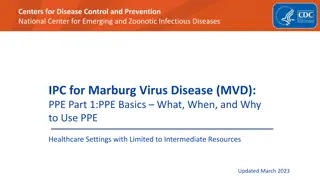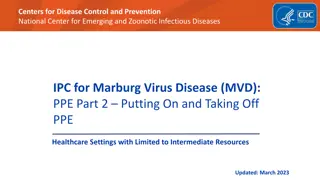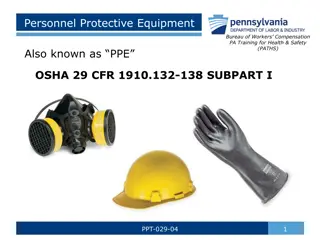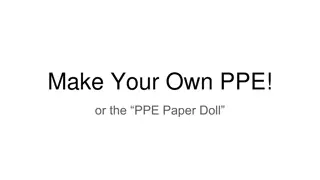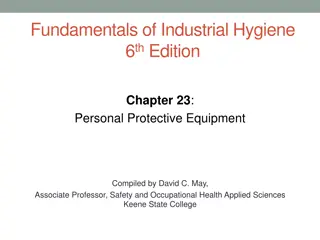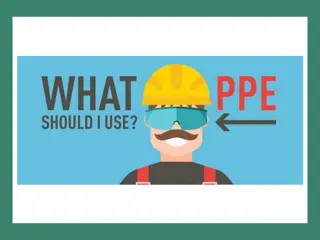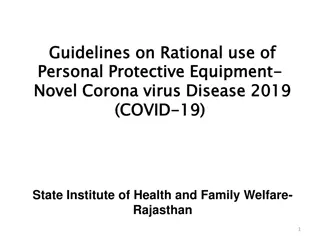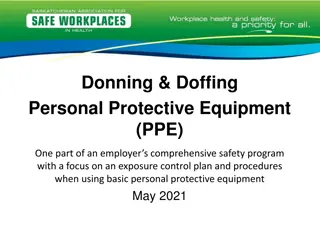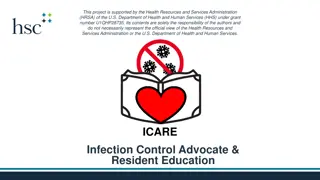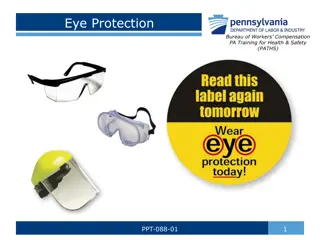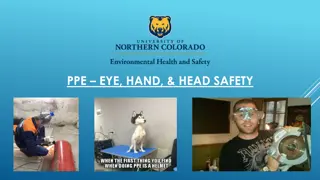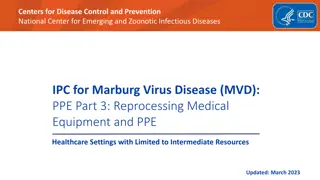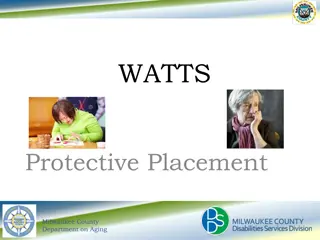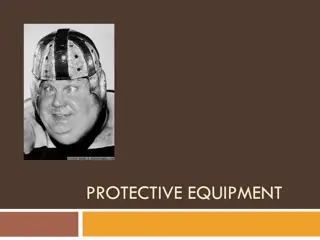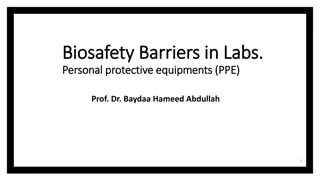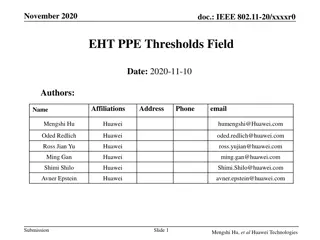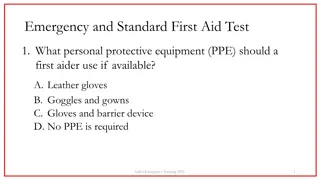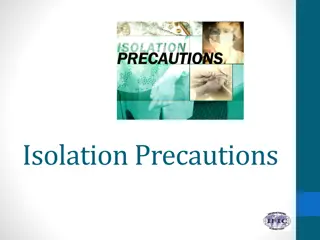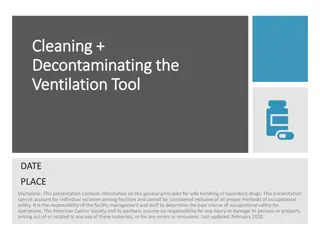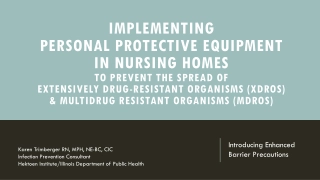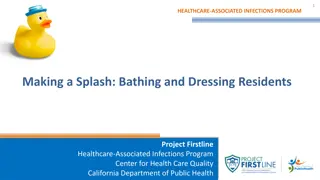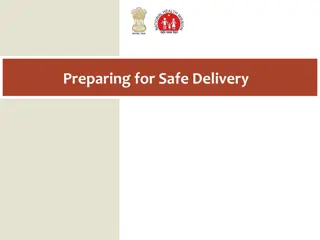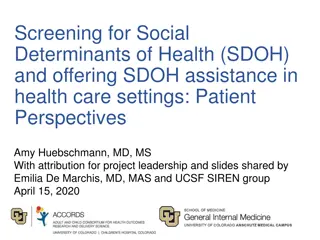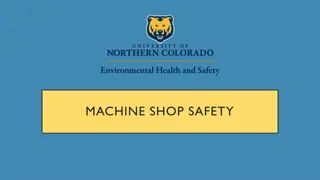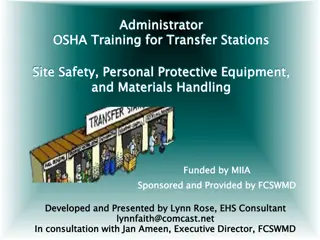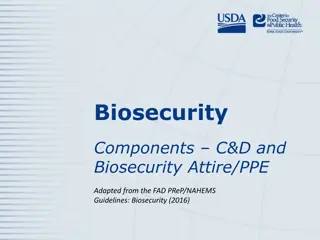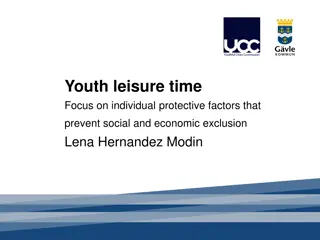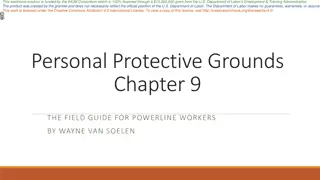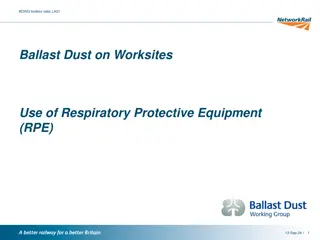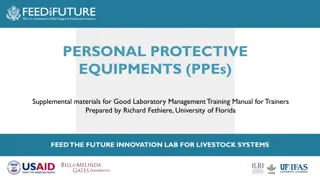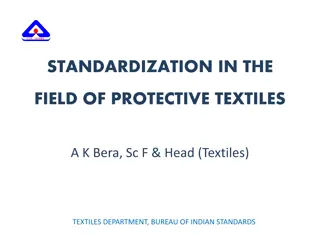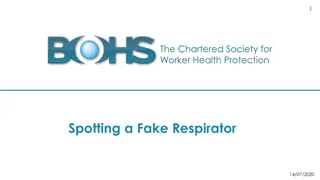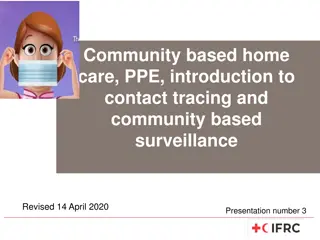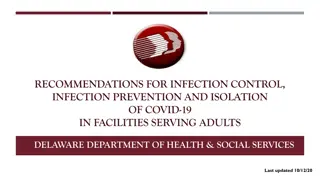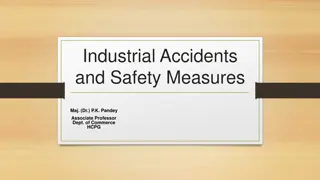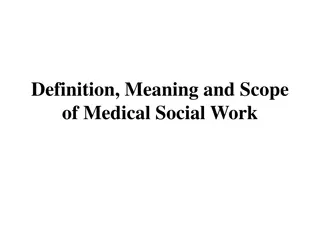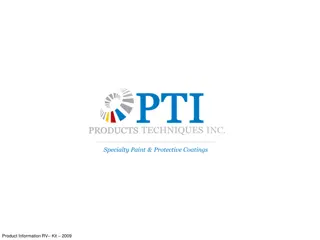Understanding Personal Protective Equipment (PPE) in Healthcare Settings
Personal Protective Equipment (PPE) plays a crucial role in infection prevention and control in healthcare settings. This comprehensive guide covers the various types of PPE, factors influencing selection, when to use PPE, and the importance of standard precautions. Learn about gloves, gowns, masks, respirators, goggles, and face shields, and how they protect healthcare workers from infectious materials. Enhance your knowledge on PPE to promote patient safety and maintain a safe work environment.
Download Presentation

Please find below an Image/Link to download the presentation.
The content on the website is provided AS IS for your information and personal use only. It may not be sold, licensed, or shared on other websites without obtaining consent from the author. Download presentation by click this link. If you encounter any issues during the download, it is possible that the publisher has removed the file from their server.
E N D
Presentation Transcript
Infection Prevention and Control A Foundation Course 2015
Standard Precautions Let s play dress up! Personal Protection Equipment and Standard Precautions. Donning and doffing Jo O Hora, IPCN CUH September 2015
Overview PPE What is PPE? Types of PPE When do you use PPE? PPE for expanded precautions Sequence for putting on PPE Sequence for taking off PPE
Personal Protective Equipment (PPE) Definition: specialized clothing or equipment worn by an employee for protection against infectious materials (OSHA)
Factors Influencing PPE Selection Type of exposure anticipated Splash/spray versus touch Category of isolation precautions Durability and appropriateness for the task Fit
Types of PPE Used in Healthcare Settings Gloves protect hands Gowns/aprons protect skin and/or clothing Masks and respirators protect mouth/nose Respirators protect respiratory tract from airborne infectious agents Goggles protect eyes Face shields protect face, mouth, nose, and eyes
When to use PPE? PPE creates a barrier between a potential infectious material and the healthcare worker Intended to promote patient safety and increase the safety of the healthcare work environment Risk Assessment!!!
STANDARD PRECAUTIONS .infection control practices used to prevent transmission of diseases that can be acquired by contact with blood, body fluids, non-intact skin (including rashes), and mucous membranes
PPE for Standard Precautions Gloves Touching, or where there is a risk touching, blood, body fluids, secretions, excretions, contaminated items; for touching mucus membranes and non-intact skin Gowns/Aprons Use during procedures and patient care activities when contact of clothing/ exposed skin with blood/body fluids, secretions, or excretions is anticipated Mask and goggles or a face shield - Use during activities likely to generate splashes or sprays of blood, body fluids, secretions, or excretions
PPE for Expanded Precautions Expanded Precautions include Contact Precautions Droplet Precautions Airborne Infection Isolation Combinations ..
Use of PPE for Expanded Precautions Contact Precautions Gown or apron and gloves for contact with patient or environment (e.g., medical equipment, environmental surfaces) In some instances these are required for entering patient s environment Droplet Precautions Surgical masks within 3 feet of patient Airborne Infection Isolation Particulate respirator* *Negative pressure isolation room also required
PPE Use in Healthcare Settings: How to Safely Don, Use, and Remove PPE
Hand Hygiene Social hand hygiene required for Standard Precautions and antiseptic hand hygiene for Expanded Precautions Perform Before donning gloves Immediately after removing gloves Between patient contacts Decontaminate hands thoroughly using alcohol- based hand rub on physically clean hands or with soap and water
Key Points About PPE Don PPE before contact with the patient, generally before entering the room Use carefully don t spread contamination Remove and discard carefully, either at the doorway or immediately outside patient room; always remove respirator outside room Immediately perform hand hygiene
Sequence* for Donning PPE Gown / Apron first Mask or respirator Goggles or face shield Gloves *Combination of PPE will affect sequence be practical
How to Don a Gown Select appropriate type and size Opening is in the back Secure at neck and waist If gown is too small, use two gowns Gown #1 ties in front Gown #2 ties in back
Face Protection Masks protect nose and mouth Should fully cover nose and mouth and prevent fluid penetration Goggles protect eyes Should fit snuggly over and around eyes Personal glasses are not a substitute for goggles Antifog feature improves clarity
Face Protection Face shields protect face, nose, mouth, and eyes Should cover forehead, extend below chin and wrap around side of face
How to Don a Mask Place over nose, mouth and chin Fit flexible nose piece over nose bridge Secure on head with ties or elastic Adjust to fit
Respiratory Protection Purpose protect from inhalation of infectious aerosols (e.g., Mycobacterium tuberculosis) PPE types for respiratory protection Particulate respirators Half- or full-face elastomeric respirators Powered air purifying respirators (PAPR) Fit testing ..
How to Don a Particulate Respirator Select a fit tested respirator Place over nose, mouth and chin Fit flexible nose piece over nose bridge Secure on head with elastic Adjust to fit Perform a fit check Inhale respirator should collapse Exhale check for leakage around face
How to Don Eye and Face Protection Position goggles over eyes and secure to the head using the ear pieces or headband Position face shield over face and secure on brow with headband Adjust to fit comfortably
How to Don Gloves Don gloves last Select correct type and size Perform hand hygiene Insert hands into gloves Extend gloves over isolation gown cuffs
Dos and Donts of Glove Use Clean your hands before donning gloves Work from clean to dirty Limit opportunities for touch contamination - protect yourself, others, and the environment Don t touch your face or adjust PPE with contaminated gloves Don t touch environmental surfaces except as necessary during patient care Take gloves off after use and clean your hands
How to Safely Use Gloves Keep gloved hands away from face Avoid touching or adjusting other PPE Remove gloves if they become torn; perform hand hygiene before donning new gloves Limit surfaces and items touched
PPE Use in Healthcare Settings: How to Safely Remove PPE
The challenge..... Skin, Clothes Contaminated After Protective Gear Removed During the removal of personal protective equipment (PPE), the skin and clothing of healthcare workers can become contaminated Fran Lowry : Society for Healthcare Epidemiology of America (SHEA) Spring 2015 Conference: Abstract 7160. Presented May 15, 2015. Virus Transfer from Personal Protective Equipment to Healthcare Employees Skin and Clothing failure to properly use PPE was a risk factor for HCW infection Lisa Casanova, Edie Alfano-Sobsey,William A. Rutala, David J. Weber, and Mark Sobsey
Contaminated and Clean Areas of PPE Contaminated outside front Areas of PPE that have or are likely to have been in contact with body sites, materials, or environmental surfaces where the infectious organism may reside Clean inside, outside back, ties on head and back Areas of PPE that are not likely to have been in contact with the infectious organism
Sequence for Removing PPE Remove Gloves first and perform hand hygiene Face shield or goggles Gown Mask or respirator
Where to Remove PPE At doorway, before leaving patient room or in anteroom* Remove respirator outside room, after door has been closed * Ensure that hand hygiene facilities are available at the point needed, e.g., sink or alcohol-based hand rub
How to Remove Gloves - Step1 Grasp outside edge near wrist Peel away from hand, turning glove inside-out Hold in opposite gloved hand
How to Remove Gloves Step 2 Slide ungloved finger under the wrist of the remaining glove Peel off from inside, creating a bag for both gloves Discard
Remove Goggles or Face Shield Grasp ear or head pieces with ungloved hands Lift away from face Place in designated receptacle for reprocessing or disposal
Removing Isolation Gown Unfasten ties Peel gown away from neck and shoulder Turn contaminated outside toward the inside Fold or roll into a bundle Discard in Healthcare risk waste stream
Removing a Mask Untie the bottom, then top, tie Remove from face Discard
Removing a Particulate Respirator Lift the bottom elastic over your head first Then lift off the top elastic Discard
Disposal of PPE It is vital that PPE is disposed of correctly: PPE from non-infectious patients can be disposed of in offensive waste - Domestic waste stream PPE from patients who are infectious must go into clinical infectious waste streams - Yellow bin PPE from cyto-toxic management must go into the cyto-toxic waste stream - Purple bin
Enhanced PPE Enhanced PPE must be used with high-risk patients - e.g. ebola virus disease (EVD) Expert guidance on ebola is continually being updated A buddy is essential in high-risk care situations such as EVD The most up-to-date guidance information on what PPE should be considered for use in caring for patients with suspected or confirmed ebola infection available on HPSC website Consult local policies and procedures in their own organisations for further information.
Conclusion PPE is part of Standard Precautions and part everyday healthcare Minimises the risks of cross-contamination between patients and between patients and staff protects you . Donning and doffing PPE correctly protects you . Hand hygiene remains the cornerstone of infection prevention and all health workers must be aware that wearing PPE does not replace the need to carry out safe, hand- hygiene practices and hand decontamination


